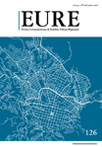Territorial externalities of global financial governance
DOI:
https://doi.org/10.4067/S0250-71612016000200010Keywords:
public policies, financial governance, public financing, monetary and exchange rate geography, crisis.Abstract
Public policies of state and supranational organisms involved in global financial governance aimed at overcoming crisis imply a reaction based on public financing and financed geopolitics, instruments controlled by the most developed economies and/or competition among them. Such post-crisis policies, mainly referring to monetary and exchange rate policies, produce territorial and urban externalities or Í€˜sub-productsÍ€™ at pluri-national and local scales, and translate into a new geography of interest rates and their corresponding differentials. This induces a reorientation of capital flows to different countries, a new geography of exchange rates and their corresponding parities, and expressions of competitive rivalry among regions and nations. These policies, which externalize many crisis costs to governments and societies of emerging nations are sustainable only for a few countries (typically the most developed ones), for the vulnerability of many others (mainly the weakest nations), in the context of unequal socio-territorial redistribution of the costs and benefits of such adjustments. The global territorial architecture resulting from these macroeconomic policies shows the non-neutral geographic and social nature of their impacts.Downloads
Published
How to Cite
Issue
Section
License
Copyright (c) 2016 Revista EURE - Revista de Estudios Urbano Regionales

This work is licensed under a Creative Commons Attribution 4.0 International License.
Al momento de aceptar la publicación de sus artículos, los autores deberán formalizar la cesión de derechos de autor a EURE, según las condiciones establecidas por la Revista.
Ésta establece que el autor autoriza a EURE de manera gratuita, exclusiva e ilimitada a reproducir, editar, publicar, distribuir, publicitar, comercializar y traducir el artículo, a cualquier soporte conocido o por conocer y desarrollar.
Del mismo modo, los autores aseguran que el artículo propuesto es original, no publicado y no propuesto para tal fin a otro medio de difusión.


